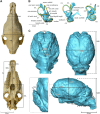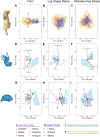Insular dwarfism in horses from the Aegean Sea and the Japanese archipelago
- PMID: 39070961
- PMCID: PMC11281976
- DOI: 10.1007/s42991-024-00408-4
Insular dwarfism in horses from the Aegean Sea and the Japanese archipelago
Abstract
The horse (Equus caballus) varieties from Skyros and Rhodes islands (Greece) in the Aegean archipelago are extremely small, reaching shoulder heights of only about 1 m. Furthermore, the Japanese archipelago is home to eight small, native horse breeds. We investigated the evolutionary morphology and provided a review of historical documentations of these horses of cultural interest in Greece and Japan, thus providing a comparison of the independent evolution of small size in islands. We integrate cranial data from historical literature with data from newly gathered and curated skulls and analyse a measurement dataset featuring various domestic and mainland horse breeds and varieties. We use non-invasive imaging to study and measure 3D models of the bony labyrinth, housing the inner ear, and the braincase endocast. When considering the effects of allometry by regressing each PC1 scores (for each set of measurements) with the cranial geometric mean from linear measurements as a body size proxy, we show that size explains a large amount of the shape variation in horse crania, the bony labyrinths and brain endocasts. We found high intrabreed variation in all the analysed datasets. Globally, there are at least 30 distinct horse populations on islands, offering the chance to further study processes of convergence in morphological divergence and evaluate the effect of drift and the environment.
Supplementary information: The online version contains supplementary material available at 10.1007/s42991-024-00408-4.
Keywords: Allometry; Bony labyrinth; Domestication; Endocast; Nanism.
© The Author(s) 2024.
Conflict of interest statement
Conflict of interestThe second author (KLV) is part of the editorial board of Mammalian Biology as an Associate Editor. The remaining authors have no competing interests.
Figures





References
-
- Amalthia (2020) Greek domestic breeds—a hidden treasure. Amalthia - Network for the Protection of Greek Indigenous Farm Animals, Athens
-
- Apostolidis AP, Alifakiotis TA, Mamuris Z, Karkavelia E (2000) PCR-RFLP analysis of mitochondrial DNA cytochrome b gene among Greek horse breeds. Ital J Zool 67(2):159–162. 10.1080/1125000000935630910.1080/11250000009356309 - DOI
-
- Apostolidis AP, Mamuris Z, Karkavelia E, Alifakiotis T (2001) Comparison of Greek breeds of horses using RAPD markers. J Anim Breed Genet 118:47–46. 10.1111/j.1439-0388.2001.00272.x10.1111/j.1439-0388.2001.00272.x - DOI
LinkOut - more resources
Full Text Sources
Research Materials
Miscellaneous
